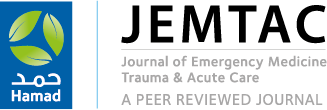-
oa Evaluation of the online continuing education experience during the COVID-19 pandemic in a Middle Eastern ambulance service: A cross-sectional study
- المصدر: Journal of Emergency Medicine, Trauma and Acute Care, Volume 2024, Issue 7, ديسمبر ٢٠٢٤, 34
-
- ٢٠ يونيو ٢٠٢٤
- ٠٢ سبتمبر ٢٠٢٤
- ٢٢ أكتوبر ٢٠٢٤
Introduction: The COVID-19 pandemic posed significant global challenges to healthcare systems, necessitating rapid education and training adaptations for frontline workers. In Qatar, Hamad Medical Corporation Ambulance Service (HMCAS) has transitioned to distance learning platforms to ensure the continuing professional development of paramedics. The aim of this study was to evaluate the effectiveness of these online learning platforms in meeting the educational needs of HMCAS paramedics in pre-hospital care.
Methods: A retrospective observational study design was followed using an online survey. Data were collected using a validated tool focused on accessibility, feasibility, and perception of online learning during the pandemic. Descriptive and inferential statistics (ANOVA) were used to estimate differences in satisfaction scores across themes and analyze the data.
Results: The findings revealed that HMCAS paramedics reported high levels of satisfaction (mean 3.93 out of 5) with online learning, citing its ability to meet their educational needs, enhance academic performance, and provide a safe learning environment. However, challenges such as poor internet connectivity, financial constraints, and lack of face-to-face interactions were identified as limitations. ANOVA results indicated that there was higher satisfaction with the online learning program, and that it met their patient care management expectations.
Conclusion: This study highlights the potential of online learning to meet the educational needs of paramedics during a global health crisis. The findings suggest that online learning can be an effective and resilient approach to education and training in future public health emergencies with appropriate quality control measures, improved feedback mechanisms, and strategies to enhance interaction and engagement.



